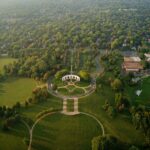Welcome to a journey through time as we dive deep into the captivating history of Omaha, Nebraska. In this article titled “Unearthing Omaha’s Fascinating Historical Facts,” we will embark on a quest to uncover the hidden gems and intriguing stories that have shaped this vibrant city. As a seasoned journalist and history enthusiast, I am thrilled to bring you a comprehensive and engaging account of Omaha’s past that will leave you enthralled. So fasten your seatbelts and get ready to be transported back in time as we explore the fascinating tapestry of Omaha’s history.
Omaha Facts History
Omaha, a city with a rich and vibrant past, holds a treasure trove of fascinating historical facts. As we delve into the pages of its history, let’s uncover some intriguing stories that shaped the city’s identity.

Native Indians and The Frontier Town
Long before Omaha became a bustling city, it was home to Native Indians who roamed the land and cherished its natural beauty. However, with the advent of Western expansion in the 1800s, Omaha transformed from a frontier town into an early center of industry, attracting pioneers and entrepreneurs seeking new opportunities.
Omaha’s history goes beyond its modern façade, reaching back to the time of Native Indians and the era of Western expansion.
The Devastating Tornado and Crossing Two States
While Omaha’s history is full of defining moments, one event that stands out is the massive tornado of 1975. This devastating natural disaster forever changed the landscape of the city, leaving a lasting impact on its residents.
Omaha’s resilience was tested when a destructive tornado descended upon the city in 1975, altering its course forever.
Did you know that you can stand in two states at once over the Missouri River in Omaha? The Bob Kerrey Pedestrian Bridge offers a unique opportunity to straddle the border between Nebraska and Iowa, serving as a symbol of unity within the city.
Come experience the thrill of standing in two states simultaneously, united by the flowing waters of the Missouri River.
Japanese Balloon Bomb and Culinary Delights
Omaha’s history also holds lesser-known tales of its involvement in World War II. In an extraordinary incident, a Japanese balloon bomb exploded over an Omaha neighborhood, reminding the residents of how global conflicts can leave an indelible mark on even the most unexpected places.
Omaha’s wartime memories resurface as we uncover the hidden story of a Japanese balloon bomb that exploded over its neighborhoods.
Beyond wartime reminiscences, Omaha boasts impressive culinary achievements. Did you know that the famous Reuben sandwich was invented right here in Omaha? This mouthwatering creation, featuring succulent corned beef, tangy sauerkraut, melted Swiss cheese, and creamy Russian dressing, has become a beloved local delicacy.
Sink your teeth into Omaha’s claim to culinary fame with the delectable invention of the Reuben sandwich.
Farm-to-Fork Movement and Sporting Greatness
Omaha is not only a city of unique historical events but also at the forefront of the farm-to-fork movement. With a commitment to locally sourced and sustainable food, Omaha embraces its agricultural roots and supports local farmers, showcasing the flavors of the heartland.
Experience Omaha’s dedication to sustainability and savor the farm-fresh delights that grace its tables.
In the realm of sports, Omaha proudly claims the title of home to the best boxer in the world. The city has produced many boxing legends, elevating its status in the world of sports.
Omaha’s fierce boxing heritage has solidified its place on the global sporting stage.
Livestock Markets and Gateway to the West
From the 1890s through the mid-20th century, Omaha rose as one of the top livestock markets worldwide and a leader in the meat-processing industry. This remarkable achievement catapulted Omaha onto the world stage, leaving a lasting impact on its economy and shaping the city as we know it today.
Explore Omaha’s evolution into a livestock powerhouse, where it once held the title of a leading global meat market.
Founded in 1854, Omaha quickly gained a reputation as a “gateway to the West.” Its strategic location made it a critical hub for travelers, traders, and adventurers alike, playing a pivotal role in the expansion of the United States.
Omaha’s history intertwines with the westward journey, positioning it as a gateway to new horizons.
As we unearth Omaha’s captivating historical facts, it becomes clear that the city’s past pulses with a vibrant energy that enriches its present. From Native Indian heritage to culinary delights, from devastating disasters to sporting greatness, the essence of Omaha’s history is an invitation to embrace its fascinating tapestry and discover the captivating stories that lie beneath its surface.
Omaha’s history beckons with stories that transcend time, weaving a captivating tapestry of the past into the present.
Omaha, Nebraska is not just your average midwestern city. It is packed with fascinating history, vibrant culture, and unique attractions that are sure to captivate any visitor. If you’re curious about fun facts about Omaha, click here to uncover a treasure trove of intriguing information about this hidden gem of a city. From legendary steakhouses to world-renowned zoos, Omaha has something for everyone. So why wait? Embark on a virtual adventure and discover all the amazing things that make Omaha truly special. Grab your sense of wonder and click here to dive into the captivating world of fun facts about Omaha.
Omaha Facts History
Welcome to Omaha, a city rich in history and filled with countless historical attractions just waiting to be explored. Whether you’re a history buff or simply fascinated by the past, Omaha has something for everyone. From the stunning architecture of the Joslyn Castle to the fascinating exhibits at the Durham Museum, there’s no shortage of things to see and learn about. For those interested in Omaha’s rich heritage, be sure to visit the Omaha Historical Society where you can delve deeper into the city’s past. And if you’re eager to discover even more, make sure to check out our comprehensive list of Omaha historical attractions Omaha historical attractions. Don’t miss out on the chance to uncover the hidden stories and incredible history that Omaha has to offer. Start your historical adventure today!
Omaha Beach: The Historic Battle of D-Day
[youtube v=”t3P11ENBZyc”]
Introduction
Omaha Beach holds a significant place in history as one of the key locations of the D-Day invasion during World War II. On June 6, 1944, the Allies executed the largest amphibious landing operation in history, known as Operation Neptune. Over 175,000 men stormed the beaches of Normandy in France, aiming to establish a second front in Europe against Nazi Germany. Within this operation, Omaha Beach played a critical role, but it became known as “Bloody Omaha” due to the immense challenges faced by US soldiers. In this article, we will delve into the details of the battle, exploring the forces involved, the German defense, and the courage and determination of the American troops.
The Battle Plan and US Forces
The assault on Omaha Beach required meticulous planning, dividing the 50-mile landing zone into five sectors: Utah, Omaha, Gold, Juno, and Sword. The US Army was responsible for securing Omaha Beach, deploying the 5th Corps comprising 43,000 men organized into two regimental combat teams. The 16th Infantry Regiment of the 1st Infantry Division formed the experienced 16th Regimental Combat Team, while the National Guard 29th Infantry Division formed the 116th Regimental Combat Team.
These combat teams were supported by tank battalions and engineering teams. Additionally, Ranger battalions were assigned the task of eliminating a German artillery battery near Pointe du Hoc village while supporting the western half of the beach.
German Defense and Obstacles
The German defense at Omaha Beach consisted of the battle-hardened 352nd Infantry Division. This unit, comprised of Eastern Front veterans and fresh conscripts, was well-prepared with 7,800 soldiers and a network of thirteen strong points positioned strategically to protect the draws and gullies leading off the beach.
Each strong point was capable of providing supporting fire to neighboring positions, forming a formidable defense. The American assault sectors, codenamed Charlie, Dog, Easy, Green, White, Red, and Fox, faced the challenging task of breaching the German strong points and pushing inland.
The Assault: A Devastating Start
As the Allied fleet arrived off the coast, bad weather proved to be a hindrance. Both air and naval bombardment missed their targets, leaving the German defenses intact. In the initial assault on Omaha Beach, soldiers faced treacherous conditions. Many landing craft carrying troops disembarked further from the beach than planned, forcing soldiers to navigate through deep water while weighed down by heavy equipment.
The soldiers were exposed to a barrage of German fire as soon as the ramps on the landing craft were lowered. This included deadly machine guns, field guns, mortars, and mounted guns. The first wave of soldiers endured heavy casualties, with many losing their lives before even reaching the water.
Adapting Under Fire
Despite the challenging situation, soldiers on Omaha Beach demonstrated incredible improvisation and resilience. They formed adhoc units, making decisions on their own to advance and overcome the German defenses. The destroyers, risking running aground, provided critical support by shelling the German strong points.
Gradually, the American forces managed to create breaches in the German defenses, particularly around strongpoint WN-62. The soldiers of Easy Company of the 16th Infantry Regiment discovered an unprotected gap between two enemy strong points, allowing them to launch a successful lateral attack. The combined effort of tanks on the ground and destroyer fire played a crucial role in weakening the German defenses.
Victory from Disaster
By the end of D-Day, the American assault forces had made significant progress in securing Omaha Beach. Although the beachhead was not yet completely secured, the soldiers had managed to widen the breaches and establish control over a piece of territory. However, this victory came at a high cost, with a staggering 2,000 to 5,000 American soldiers killed, wounded, or missing in action.
Despite the immense difficulties faced, the bravery and determination of the soldiers on Omaha Beach turned what initially seemed like a disaster into an eventual victory. The success of D-Day and the establishment of a strong beachhead paved the way for the ultimate defeat of Nazi Germany and the liberation of Europe.
Conclusion
Omaha Beach will forever be etched in history as the site of one of the most significant battles of World War II. The bravery and sacrifice of the American soldiers who stormed this treacherous beach are a testament to the spirit of determination in the face of adversity. Omaha Beach stands as a solemn reminder of the price of freedom and the courage of those who fought for it.
“The soldiers on Omaha Beach demonstrated incredible resilience and improvisation, turning an initial disaster into an eventual victory.”
FAQ
Q: What was Omaha like before Western expansion?
A: Omaha was originally home to Native Indians and largely a frontier town before Western expansion.
Q: When did Omaha come about and how did it develop?
A: Omaha came about in the 1800s as part of the Louisiana Purchase and was an early city of industry.
Q: What is the most notable event in Omaha’s history?
A: The most noted aspect of history in Omaha was the huge tornado of 1975.
Q: Is it true that you can stand in two states at once in Omaha?
A: Yes, you can stand in two states at once over the Missouri River in Omaha.
Q: Are there any unique events that occurred during World War II in Omaha?
A: Yes, a Japanese balloon bomb exploded over an Omaha neighborhood during World War II.
- Unlock Water’s Symbolism: A Cross-Cultural Exploration - April 20, 2025
- Identify Black and White Snakes: Venomous or Harmless? - April 20, 2025
- Unlocking Potential: Origins High School’s NYC Story - April 20, 2025















